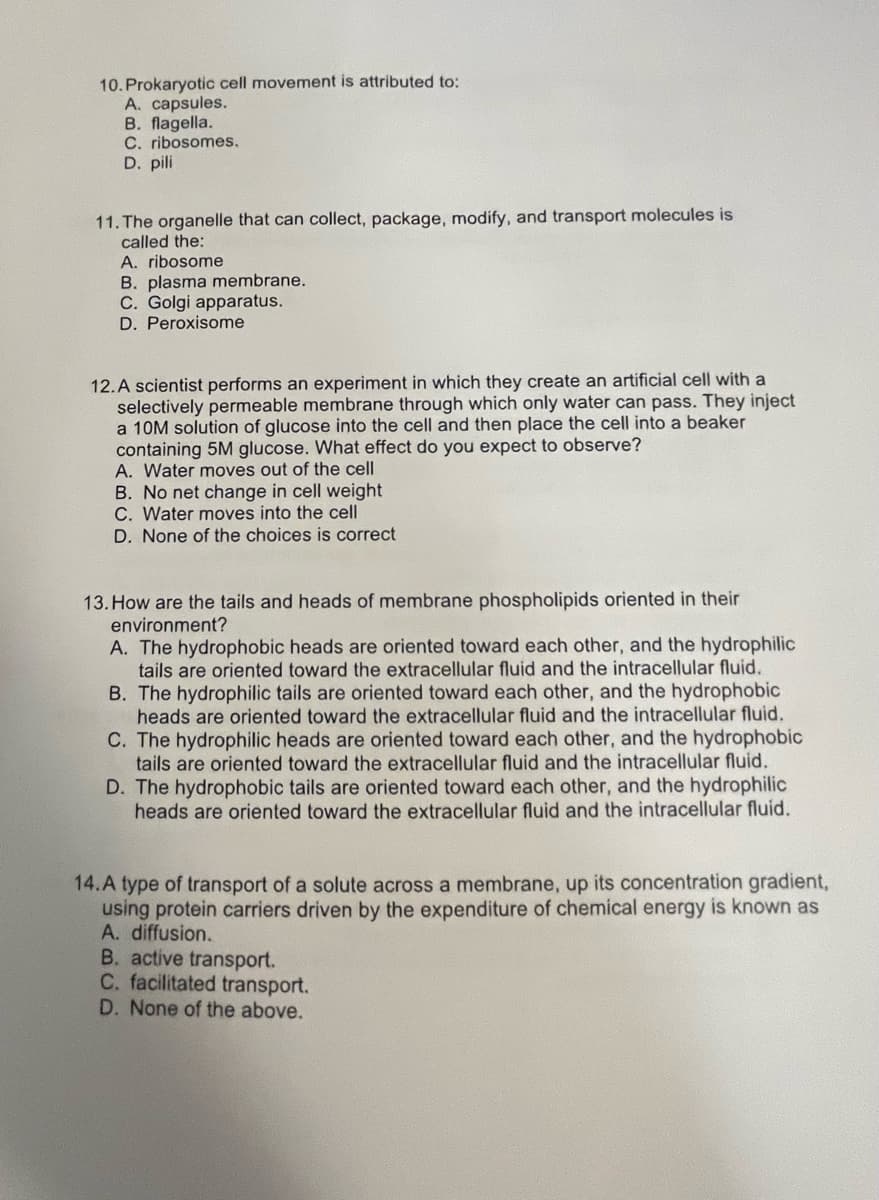10. Prokaryotic cell movement is attributed to: A. capsules. B. flagella. C. ribosomes. D. pili 11. The organelle that can collect, package, modify, and transport molecules is called the: A. ribosome B. plasma membrane. C. Golgi apparatus. D. Peroxisome 12.A scientist performs an experiment in which they create an artificial cell with a selectively permeable membrane through which only water can pass. They inject a 10M solution of glucose into the cell and then place the cell into a beaker containing 5M glucose. What effect do you expect to observe? A. Water moves out of the cell No net change in cell weight C. Water moves into the cell D. None of the choices is correct 13. How are the tails and heads of membrane phospholipids oriented in their environment? A. The hydrophobic heads are oriented toward each other, and the hydrophilic tails are oriented toward the extracellular fluid and the intracellular fluid. B. The hydrophilic tails are oriented toward each other, and the hydrophobic heads are oriented toward the extracellular fluid and the intracellular fluid. C. The hydrophilic heads are oriented toward each other, and the hydrophobic tails are oriented toward the extracellular fluid and the intracellular fluid. D. The hydrophobic tails are oriented toward each other, and the hydrophilic heads are oriented toward the extracellular fluid and the intracellular fluid. 14.A type of transport of a solute across a membrane, up its concentration gradient, using protein carriers driven by the expenditure of chemical energy is known as A. diffusion. B. active transport. C. facilitated transport. D. None of the above.
Cell Structure
The knowledge and concept about the structure of the cells have changed constantly over the past years. Primarily the scientist defines the cells as a simple membranous sac with fluids and some particles. Researches have now revealed that the cell is the more complex and basic unit of life. There are different types of cells and they also differ in shape and structure. The basic three parts of a cell are cell membrane, cytoplasm, and organelle.
Plant Cell
The smallest functional unit of a living organism is known as the cell. It is composed of cytoplasm enclosed by an outer layer known as the cell membrane. A cell is classified as a prokaryotic cell and a eukaryotic cell. A prokaryotic cell does not contain a nucleus, and the genetic material is freely suspended in the cell cytoplasm; for example, bacteria are composed of a prokaryotic cell. Whereas a eukaryotic cell contains a nucleus and membrane-bound cell organelles with a specific function, plants and animal cells are examples of eukaryotic cells.
Plant Cell Types
Plants are made up of a variety of cell types that include both living and dead cells. These cells provide them mechanical and structural support along with the growth of plants. Plant tissue is a group or collection of cells, which are similar in structure and work together to accomplish a specific function. Plant cells are most similar to animal cells, both being eukaryotic cells.

Trending now
This is a popular solution!
Step by step
Solved in 5 steps









